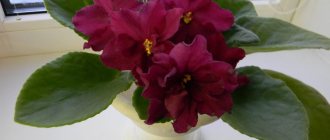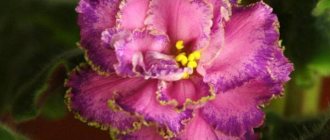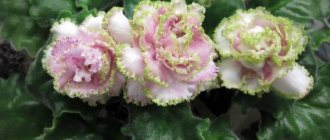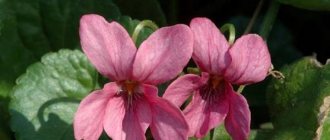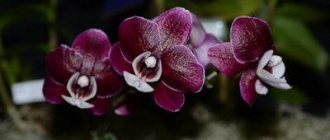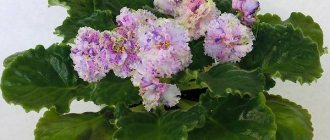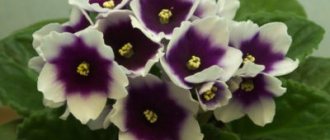general description
Winter cherry
Frost
Cherry Violets are perennial plants with petiolate leaves. Violet flowers come in a variety of colors and are single. The leaves of the plant have the shape of a heart, the stem is creeping. The fruit is presented as a capsule with valves.
Breeders do not stop developing more and more new species and varieties of violets, and therefore making a choice is becoming more and more difficult.
Plants that are inconspicuous at first glance are capable of turning even the smallest windowsill into a stunningly beautiful flower bed during their flowering.
Among the variety of varieties, the varieties of violets “Cherry” stand out for their elegance, namely “Frosty Cherry” and “Winter Cherry”.
A distinctive feature of violets of the “Frosty Cherry” and “Winter Cherry” varieties is that they have a breathtaking dark cherry color with a white border along the edges of the petals.
This is very reminiscent of bright red cherries in the snow, dusted with frost, which gives the varieties their name.
When and how does it bloom
Violet Blue Dragon - description and characteristics of the variety
Traditionally, Uzambara violets bloom most profusely in spring, winter and autumn. Depending on age and care, year-round flowering can be achieved. The forcing of new flower stalks with a constant supply of nutrients occurs at intervals of 2-3 months, but the buds do not bloom all at once, but gradually, one at a time.
Blooming rosette of frosty cherry
Types of flowers
Mature Frost Cherry plants usually have flowers that differ from each other slightly only in size. However, when the conditions of the plant change, the color of the petals may change. If the air temperature rises, the flowers darken, and when it gets colder, they lighten, their light border becomes wider.
Flower shapes
Corolla of Saintpaulia Frosty cherry semi-double. The core of the flower is surrounded by 2 rows of petals (5-7 pieces each), and another row of slightly smaller petals is grouped in the center. The edges of the petals are slightly corrugated.
Flowering period
The most important condition for the start of flowering is temperature and a light regime of 12 hours. As soon as the air cools or heats up too much, flowering stops.
For your information! With proper care, the Frosty Cherry variety blooms all year round with short pauses of 1-1.5 months.
Changes in care during the flowering period
When forcing buds, it is important to provide regular and systematic feeding with organic and mineral fertilizers. Violets require nitrogen in minimal quantities, unlike potassium and phosphorus. Fertilizers for indoor flowering plants, for example, Agricola, are suitable, but the concentration is reduced by 2 times from that recommended by the manufacturer, so as not to provoke active growth of green mass to the detriment of flowering. The frequency of feeding is every 10-14 days.
Origin story
Frosty Cherry
The charming variety “Frosty Cherry” appeared thanks to the hard work of the Russian breeder Konstantin Morev in 2005. 11 years of work culminated in the creation of an extraordinary plant with perfect flowers.
Flowers of various rich cherry shades, with bright strokes or as if covered with frost, look equally magical.
The most interesting variety “Winter Cherry” was also created by Russian breeder Elena Korshunova in 2006. This is a talented specialist with many successful works behind him.
Both varieties of “Cherry” are among the young, extremely popular due to their colorful, very effective combinations of cherry and white flowers.
What the violet Frosty cherry looks like: description
This is a semi-double variety with juicy cherry-colored petals with a white or pale pink border and leaves of a pleasant even green color. The socket is standard size and compact.
Blooming Saintpaulia Frosty cherry selection Moreva
Plant characteristics
Violet is interesting primarily for its unusually lush and beautiful flowers. The diameter of the corolla reaches 4 cm. The petals are collected into a semi-double flower, in the center of which large yellow stamens are hidden. The edges of each petal have a smooth or wavy border of white or pink, and the central cherry spot has a noticeable shift from light to dark.
Variable petal color
The leaf is velvety with noticeable pile, it is green, elongated, heart-shaped. The surface has a matte sheen and is lumpy at the veins, creating a quilted effect. The petioles are long and pubescent. The root system is standard for Saintpaulias - branched, superficial.
For your information! Usambara indoor violets belong to the extensive genus Saintpaulia (Saintpaulia) of the Gesneriaceae family. Homeland - the highlands of North Africa (Tanzania, Kenya). Under natural conditions they grow along river terraces, next to waterfalls, where moisture is constantly present in the air.
The prominent Russian breeder K. Morev has been breeding the Frosty Cherry variety for at least 10 years. Today it can be purchased in specialized stores throughout the country and abroad.
Differences from the EK-Winter Cherry variety
Some similarity with the original variety authored by K. Morev is demonstrated by a violet with a similar name, bred by breeder E. Korshunova. But the two flowers are similar only at first glance; there are quite a lot of differences between them. Violet Winter cherry Korshunova has less double flowers with a diameter of not 4, but 7 cm. The border of a light pink shade along the edge of the petals is very narrow and sometimes almost invisible, and the middle is a denser, purple cherry tone. The leaf is larger and darker in color. In a word, it is impossible to confuse the sockets standing next to each other, although both are excellent.
Saintpaulia EK-Winter Cherry
Appearance: description
Frosty cherry
“Frosty cherry” is a violet that has large double flowers about 4 cm. The color range is represented by both crimson and pale pink shades.
The petal presents a color transition, from a rich cherry red in the center to a soft white stripe along the edge.
An impressive characteristic of the gardener is the ability of a flower to change color with changes in temperature in the environment.
The flowers turn dark cherry red at high temperatures and lighten as the temperature drops.
And also, depending on the time of flowering, the stability of lighting, the saturation also changes. The rosette of the plant has a standard appearance and size, represented by simple pointed leaves.
Long-lasting, up to 10 months, and abundant flowering makes the plant one of the favorites of gardeners. The number of flower stalks can be increased with the help of special fertilizers. Biological rest is extremely useful.
The appearance of darkening petals, as a rule, indicates the aging of the plant.
Violet "Winter Cherry" has huge, semi-double flowers to the touch, with wavy edges. The petals in the center are thick cherry, almost black in color, and seem to be frosted along the edges. This variety is also characterized by a change in color with changes in temperature.
Reviews
Alyona. “The variety is very beautiful. Smart. He wouldn't even have a price. If only the beetroot shades and juiciness did not disappear during flowering. It fades a little after blooming.”
Natalia. "Not only me. But many owners of this variety notice a bright and rich color when blooming. And faded towards the end of flowering. But this is typical for many flowers. Not only Saintpaulia. Take bright colors of roses. What are they like when they fall? But this must be known and taken into account.”
Valentina Vasilievna. “Flowers are not just beautiful. They are very beautiful!!! After all, the size of the flowers is substantial - about 7 cm. Large semi-double wavy cherry-red flowers with a white “frosted” border along the edge of the petals. Standard green socket. This is how Elena Korshunova herself introduced them. This is how they turned out for me. The color changed from dark cherry to lighter as it bloomed. And it doesn’t upset or embarrass me.”
Care
Frosty cherry
The health and appearance of violets depend on the grower’s ability to provide their needs for watering, lighting and nutrition. Under optimal conditions, violets bloom for nine months of the year.
Temperature
The violet can tolerate short-term temperature drops of up to 12 °C, but it needs warmth for normal development.
The plant feels comfortable if the thermometer shows 20-22 degrees Celsius.
Sharp temperature fluctuations are contraindicated for the flower.
Lighting
Winter cherry
Windows with eastern or western orientation are most suitable for placing violets. To get an even rosette, the flower is periodically turned. If Saintpaulia is placed far from the window, it is provided with additional lighting.
Important! Correctly selected lighting is the key to abundant flowering of violets. With a lack of lighting, leaf cuttings stretch and rise, and the color of leaves and flowers loses saturation and brightness.
Direct sunlight can cause burns on the leaves, so the plant should be shaded from excessively bright light.
Watering
You can provide violets with moisture in different ways: use wick watering, water in a tray or from above.
Wick watering will help the gardener save time. In this case, a string is placed in the pot, passing it through the drainage hole.
The part of the wick that comes out is lowered into a container of water. When using the “bottom watering” method, water is poured into the pan for 20 minutes, then the excess is drained.
Most often, this method is used in greenhouses for the mass cultivation of Saintpaulias, but it can also be used in indoor floriculture.
Most often, ordinary people water homemade violets from above, carefully moistening the earthen ball.
In this case, it is necessary to follow certain rules: Water if the surface of the soil in the flower pot is dry. At different times of the year, the frequency of watering differs. In winter, you can moisten the plant 2-3 times a week, and in summer this procedure is carried out daily.
It is advisable to use settled water at room temperature.
Moisten the plant evenly, trying not to create stagnation of moisture and not leave dry areas. Excess water is drained from the pan after a quarter of an hour.
Humidity
The most suitable humidity for growing Saintpaulias is 50%. In a drier atmosphere, the flowers will be slightly smaller and the leaves denser.
The critical time for Frosty and Winter cherries is the heating season, especially if the flower is located near radiators. Streams of hot air negatively affect the plant, its leaves begin to turn yellow.
Attention! Violets, like other flowers with pubescent leaves, do not like spraying. Therefore, when growing these flowers, other methods of increasing humidity are used.
To humidify the air, plants are placed in a tray with damp expanded clay or moss, or containers filled with water are placed next to the pots.
The presence of a humidifier or air washer in the apartment completely removes the problem of achieving the required humidity.
Priming
The delicate roots of violets are very sensitive to soil. Therefore, when choosing a substrate, you need to remember that it must be loose and nutritious.
When preparing a soil mixture, violet growers often use peat and agroperlite with the addition of crushed moss. Peat (or light garden soil) is a filler.
Perlite (like vermiculite, sphagnum, sand) acts as a leavening agent, providing good moisture retention and breathability. You can also add nutritious compost soil or humus.
As for the exact proportions, there are many recipes. For example, in the book of the famous breeder Boris Mikhailovich Makuni there is such a description: high-fiber coarse-fiber peat - 2 parts, sphagnum moss and turf soil - one part each, river sand - 0.5.
Attention! When independently preparing soil for violets, it must be sterilized.
To do this, you can spill the soil with boiling water or a strong solution of potassium permanganate. Sometimes the soil mixture is frozen, which also helps get rid of harmful insects.
Flower growers who do not have a lot of time use commercially sterilized components or ready-made mixtures for Saintpaulias.
Feeding
Violet cherry, like other plants that are in a limited volume of substrate, needs regular feeding.
However, it should be noted that too concentrated solutions are harmful to plants. Violets tolerate a lack of fertilizer better than an excess. For Saintpaulia, the optimal solution is considered to be a solution in a concentration of 1 g of complex mineral salts per 1 liter of water.
This feeding is carried out once every 2-3 weeks. In addition, excess potassium leads to stunting of growth, and excess nitrogen, on the contrary, promotes the growth of green mass to the detriment of flowering.
Therefore, nitrogen fertilizers are suitable for children, and phosphorus fertilizers are chosen for plants with buds.
Typically, complex fertilizers with a low nitrogen content are used for violets.
It is useful to alternate mineral and organic fertilizers. After transplanting into fresh soil, no fertilizer is applied for two weeks.
During the dormant period, the plant is also not fertilized.
For reference! Peters fertilizers give good results. This manufacturer offers different formulas for the flowering and growth of violets.
The use of Osmocote long-acting fertilizers saves time and gives a visible effect. The granules are placed in a pot during transplantation and over several months, under the influence of water, microelements are released and nourish the plants.
Plant care
Let us consider separately each component of proper care for the “Winter Cherry” violet:
Temperature. Favorable for the flower – 10-15 degrees. It blooms at a temperature of 20-25 degrees. The violet dies if it gets cold below 5 degrees or hot (over 30 degrees).
Blooming violets on the windowsill (photo)
Humidity. Violet thrives at a humidity of 60-80%. The flower does not like spraying. A shower is suitable to clean the leaves from dust.
Illumination. For a flower, it is necessary to provide lighting up to 12 hours a day. It should be bright, but not as bright as possible. If there is not enough light, the leaves and petioles begin to stretch upward.
Watering. The violet does not require abundant and frequent watering. It should be regular, but not strong, just along the edge of the pot. Excess water will drain into the pan, and from there it must be removed in a timely manner, without causing it to stagnate. It is necessary to water with warm water, or at room temperature.
Feeding. Overfeeding the plant is dangerous; it may simply die. It is enough to feed the plant with special means a couple of times a month. After transplantation, additional funds will be required only after two weeks.
The flower is replanted twice a year, but the pot must be increased only in width. You can leave the soil the same if the plant is healthy. If any problems arise, the soil must be demolished and replaced with a new one.
Drafts and open windows are also harmful to the plant. The appearance of the flower loses its beauty. The sun's rays can burn leaves in just a matter of minutes.
The leaves turn yellow, shrink and die. For this reason, violets have no place on the sunny side of the windowsill.
Bloom
Violet winter cherry
Not greedy for flowering, the Winter and Frosty cherry varieties delight with beautiful flowers almost all year round. In winter, it is recommended to create a dormant period for a couple of months, reduce watering and not add additional light.
After this, you need to create favorable conditions for growth - and soon an elegant bouquet will be formed. Peduncles appear in the axils of the leaves, each bearing several flowers. Mature plants are prone to cap flowering.
To extend the flowering time, do not forget a few simple rules:
- It is important to provide the violet with good lighting. With a lack of light, the flowers fade, and the leaves and peduncles become elongated.
- Wilted flower stalks need to be removed.
- For flowering plants, the daylight hours should be 12 hours.
- During budding and flowering, violets need fertilizing and frequent watering.
Features of flowering, growth and reproduction
Very often, flower growers compare this Saintpaulia by E. Korshunova with Frosty Cherry by K. Morev . They are even similar in appearance. Not just with cold red cherry names.
Development at home
Under the right conditions, this violet will not keep you waiting long for it to bloom. This is what flower growers note. Especially those who make money from them.
They bloom for up to 9-10 months. After you create optimal conditions.
How long does it take to grow an adult plant?
If Winter Cherry cuttings are successfully rooted, shoots (babies) may appear within a month.
And after 2-3 months, when 2 leaves appear, you can start planting them (pique).
And only (or maybe already) after 9-12 months they can bloom.
Do you consider him already an adult? I wouldn't rush.
How are varietal characteristics transmitted?
Winter Cherries are rarely propagated by seeds. This requires more time and effort. And there is very little guarantee that you will get a copy of it from seedlings. Its seeds are often used for pollination and obtaining new varieties.
The resulting offspring from rooted cuttings of this variety retain the properties of the mother plant. For this:
- Select a healthy leaf from the middle of the rosette;
- Root it in a way that suits you;
- From one leaf you can get more than 3-4 babies;
- After picking and replanting 2 times into pots of the same size, you will have a starter. Ready to bloom.
Shoots (babies) cut from an adult plant will shorten your wait for this variety to begin flowering.
The same variety grows from a flowering peduncle.
The nuances of flowering in hot and cool conditions
High and low temperatures during their cultivation do not pass without leaving a trace:
- The white border may disappear, and the flowers almost become completely red. Without whiteness. If the heat prevails ;
- At lower temperatures, you yourself will notice their lightening. Yes, and brightness;
- By the end of flowering, they are also not as richly colored as when blooming;
- Don't forget about photo quality.
The bottom one (made with a flash) is significantly different from the top one.
What do flower stalks look like?
Two or three buds are formed on each peduncle. But they keep the flowers upright. None of the flower growers complained about them being overwhelmed.
You can even turn your attention to them.
Is it possible to achieve cap flowering?
Cap flowering attracts many buyers. This is achievable with Winter Cherry . The formed powerful rosette forms about 10 flower stalks simultaneously for flowering .
Exhibition specimens are formed by flower growers.
Bud lifespan
You don't need to focus too much on the bloom of one bud. He is replaced by others. And the whole bush pleases with flowering for 9-10 months.
But you need to remove the already faded bud. To maintain aesthetics and strength for the growth of new buds.
Growing
Landing
To plant an adult plant, it is advisable to use a pot that is not too deep and without drainage. The soil should be light and loose, and therefore the soil composition is: 3 parts - peat, 1 part - baking powder and 1 part - Vermion soil.
When planting violets with seeds, there is no guarantee that the flower will inherit all the maternal characteristics.
Mixes and pots
You can take a special mixture for violets or a mixture of coniferous, turf and leaf soil, add a little peat and baking powder.
The described varieties of violets do not like deep, large pots, since their roots are located in the top layer of soil. For convenience, it is better to use low dishes.
Home care
Proper watering and fertilizing
Water is the basis of plant life. Watering greatly affects the health and growth of violets. The need for watering depends on the conditions of detention:
Violets require proper watering.
- Light intensity;
- Temperatures;
- Air humidity;
- Soil composition;
- The material from which the pot is made;
- Plant age.
Saintpaulias are very demanding on the quality of watering. An individual approach is important here. The violet needs to be watered when the top layer of the substrate has dried, and this happens in different plants at different intervals.
When watering, you need to make sure that moisture does not get on the surface of the leaves, and especially on the growing point.
ATTENTION! Saintpaulias are watered with settled tap water at a temperature of 23-25 degrees.
Professionals water violets with special devices, which are a container with a long spout or a thin hose.
Air is pumped into such a device, it pushes water out of the container in a thin stream, which is directed to the edge of the earthen clod, avoiding splashing.
At home, such a device can be successfully replaced by a 150-200 ml syringe with a long spout.
Another method of watering is by immersing in water to 1/3 of the height of the pot.
So you need to moisten the substrate carefully and not often, since with such watering there is a high risk of root rotting
With all the wealth of choice, liquid fertilizers are optimal for violets. They are easier to handle and easier to dose.
Basic rules for feeding violets:
- Young rosettes are especially demanding of nitrogen content. There should be more of it than phosphorus and potassium;
- During the budding period, the plant needs phosphorus;
- Potassium is needed to prolong flowering;
- It is better to fertilize from above, combining with watering;
- Choose a complex fertilizer containing all the main macro and microelements in chelated form;
- Sometimes simple transshipment will be more beneficial for the plant than fertilizing.
Lighting and temperature
Greenhouse effect is a light-loving variety, but does not tolerate direct light. The most comfortable for him will be a western or eastern window. Plants located on the southern windowsill need to be shaded.
The temperature in the room with violets should be maintained in the range of 20-24C. Young violets love warmth - the optimal temperature for them is 23-25C.
ADVICE! There should be no sharp changes between day and night temperatures.
Effect of air humidity
Saintpaulias in their homeland, in the African mountainous regions, live along the banks of rivers and near waterfalls; air humidity is very important for them. A humidity level of 60-70% will best affect the well-being of violets.
Adult plants feel good even at lower humidity (30-40%) with regular watering and a comfortable temperature. Young plants are more sensitive to air humidity.
In winter, the air in apartments is dry and to maintain comfortable conditions it is necessary to humidify the air. Whether it’s an air humidifier or homemade products from improvised means, the choice is yours.
Soil requirements
The soil in which the Greenhouse Effect violet grows is selected so that it is light, permeable to air and water, does not caking, and is slightly acidic (pH 5.5-6.5). The substrate should not contain pests and their larvae, pathogens.
IMPORTANT! Without properly selected, balanced soil, this Saintpaulia variety cannot be grown.
High-moor peat with adjusted acidity using additives is considered optimal for growing Saintpaulias.
Soil for violets can be bought at any flower shop.
Approximate soil composition:
- Greenword soil or high-moor peat – 5 parts;
- Vermiculite or Perlite – 2 parts;
- Sphagnum moss or coconut fiber - 3 parts;
- Nutrient soil – 1 part;
- You can add crushed charcoal and dolomite flour.
Pruning and hygiene
In order to achieve maximum decorativeness of the violet, a rosette must be formed. For good development of flower stalks from axillary buds, the Saintpaulia bush should consist of approximately three tiers. The leaves below can be safely removed. Together with:
- Empty peduncles;
- Yellow, sickly, damaged leaves.
As the lower leaves are removed, the stem of the violet is exposed. The leafless stem is covered with fresh soil.
Give the violets in your collection a weekly inspection. During this inspection, check:
- Soil moisture;
- The need to add substrate;
- Presence of signs of parasites (cobwebs, wilting) and diseases (wet areas, spots);
- Do I need to remove wilted leaves and flower stalks?
Dust harms the fluffy leaves of violets. Wash it off under the tap, after placing the pot in a bag and tying it so that the water does not get on the soil.
IMPORTANT! Each leaf is washed separately under a thin stream of warm water.
Nuances of propagation and transplantation
Frosty cherry
Seed propagation of violets is a very labor-intensive process. The flower is pollinated, the seed pod is waited for to ripen, and tiny seeds are sown in the greenhouse. You will have to wait at least a year for flowering, and the result is unpredictable.
Seedlings can repeat the flowering of their parents, but flowers often appear that differ in both color and size. Interesting! According to esotericists, violet is a plant of Taurus and has energy that brings material well-being.
The most common method of propagation is from leaf cuttings.
Propagation by cuttings
A healthy large leaf is cut with a clean knife and placed in a glass of water or directly into the ground. It is recommended to cover the sheet with a bag or jar.
When the emerging babies reach 1/3 of the mother leaf in size, they are planted in separate pots. Such plants retain all varietal characteristics and bloom for 8-9 months from the moment of rooting.
If the Saintpaulia roots have filled the pot, it is transplanted into a container with a slightly larger diameter.
Adult plants are replanted once a year, young plants - every 3 months. Violets love fresh substrate and respond to replanting with active growth or budding.
Transplantation after purchase and during reproduction
It is recommended to transplant the plant from the shipping container into a new pot immediately after purchase. Often in stores flowers are in pots that are too large. For an adult Saintpaulia, the maximum pot diameter is 9 cm, and for young ones even less. Young violets, formed from a leaf or peduncle, must be planted in individual pots with a starting diameter of no more than 5 cm. When the young rosette has collected green mass, the next transplant occurs after 3-4 months into a pot with a diameter of 6 cm.
The soil must be mixed with disintegrants (sand, vermiculite, charcoal) to achieve high breathability. There is no need to put drainage at the bottom of the planting container, but the holes for watering must be large.
Note! Some gardeners who prefer wick watering, on the contrary, place more drainage at the bottom of a pot with one hole and place a wick in the soil, the end of which is immersed in a deep pan with water at the bottom.
Diseases and pests
Frosty cherry
Unfortunately, plants can also get sick. The use of new pots and new soil when planting is a measure to prevent the appearance and development of diseases.
Plant diseases and their probable causes:
- The presence of holes and yellow spots on the leaves means excessively bright light.
- Leaves turning pale, curled edges – cold.
- Rotting roots - excessive watering with cold water.
- Falling inflorescences mean too much fertilizer.
The most common pests are cyclamen mites and thrips. The tick is not visible to the naked eye. It settles at the growth point, as a result the center of the rosette is deformed and covered with gray fluff. Flowers wither and leaves become brittle.
To combat ticks, use Actellik or Nissoran. Thrips are small, rapidly reproducing insects. Signs of damage by this pest are spots, plaque and holes on the leaf blades. They get rid of thrips with the help of the drugs “Akarin” and “Confidor”.
Possible problems in growing
Healthy violets are pleasing to the eye and evoke a lot of positive emotions. Unfortunately, weakened specimens are susceptible to diseases and attacks by harmful insects.
The most common pests are cyclamen mites and thrips.
- The tick is not visible to the naked eye. It settles at the growth point, as a result the center of the rosette is deformed and covered with gray fluff. Flowers wither and leaves become brittle. To combat ticks, use Actellik or Nissoran.
- Thrips are small, rapidly reproducing insects. Signs of damage by this pest are spots, plaque and holes on the leaf blades. They get rid of thrips with the help of the drugs “Akarin” and “Confidor”.
Frosty cherries can be affected by powdery mildew. This is a fungal disease in which a white coating appears on the leaves and stems. The plant is treated with the drug "Fundazol".
The cause of spots on the leaves may also be improper care. Too large a pot, bright direct sun, excessive watering - all this causes a failure in the development of Saintpaulia. Bringing the conditions of detention to normal solves this problem.
Violet Frosty cherry requires some effort to organize optimal conditions for it. But it pays off with bright and abundant flowering for many months.
How Saintpaulia Frosty Cherry Moreva propagates
All Saintpaulias are easily propagated vegetatively: by leaves and even a segment of the leaf blade, peduncles, and also by children formed at the roots. Rooting of leaves and peduncles can be done in water or substrate. Root formation occurs on average in 4-6 weeks. But the flowers of daughter plants do not always repeat the parental color; in such cases, breeders talk about getting a sport.
Flowering period
The size of the flowers of the Frost Cherry variety varies depending on the number of blooms. The more there were, the larger the size of the violet petals. The saturation of shades is determined by the time of flowering. The fading buds are much brighter than those that have just appeared. The value of Saintpaulia Frosty Cherry lies in its long flowering period. It lasts up to 10 months. However, to do this, the plant must be properly cared for. You can extend the flowering period, as well as their quantity, by using fertilizers.
Conditions of detention and care
Violet Frosty cherry is warm and light-loving.
It is possible to achieve the correct flowering and development of the plant, characteristic of the variety, only if the following conditions are met:
- Sufficient illumination. The violet reacts to a lack of light by stretching out the peduncles and turning the flowers pale. Violet needs bright but diffused light, so it is better to install it on east or west windows. The leaves should not be exposed to direct sunlight, which will cause burns. Excessive light causes clogging of the center of the socket, so in summer it is better to shade it even on eastern and western windows.
- Air temperature from 20 to 25 degrees. A decrease or increase in temperature will not destroy the violet, but will affect flowering. In the heat, the flowers will be small, and at temperatures below 16 degrees the violet will stop blooming altogether.
- In insufficient light, the flowers of the Frosty cherry violet turn pale.
Air humidity is not less than 40 and not more than 65%. Heat combined with high humidity affects the flowers: they become simple, without terry. The room where the violet is located must be ventilated daily. The lack of moisture is compensated by installing open containers with water next to the violet. Spraying the plant to replenish moisture deficiencies is contraindicated.
- Regular watering with soft water at room temperature. The plant should be watered only after the soil has dried to a third of its height. Overwatering leads to rotting of the root system, and the plant may die.
Organization of fertilizing
Overfeeding violet Frosty cherries is harmful. The variety does not like nutrient-rich and dense soils. Such compositions inhibit the plant and reduce the quantity and quality of flowers. The violet begins to hurt.
If the plant shows signs of depression and begins to lose its attractiveness, it is recommended to replant and replace the soil. The soil needs to be poor in nutrients and as light as possible.
Adult plants are fed once every 2-3 weeks with organic and mineral compounds. Organic matter is added during the formation of the rosette, mineral mixtures are added during flowering. The first feeding is carried out 30 days after transplantation.
Transfer schedule and rules
Frost cherry violet is replanted twice a year. In this case, the size of the pot is gradually increased as the roots of the rosette grow. The maximum diameter of a pot for an adult violet is 12-13 centimeters.
A complete replacement of the soil during replanting is done if there is a suspicion of the presence of a disease.
If the plant looks healthy, transplantation is carried out together with a clod of earth. The slightest signs of trouble are a reason to completely replace the soil
In this case, remove the violet from the pot, carefully shake off the old soil from the roots and place the plant in a new pot.
To grow violets, you need the lightest and loosest possible soil. Special soil for violets is ideal, but to increase looseness you need to add perlite or vermiculite, approximately 10% of the total volume.
If it is not possible to purchase ready-made soil. You can prepare the substrate for planting yourself. The basis of the mixture is leaf or turf soil. It needs to be added to the mixture of 5 parts.
Add 3 parts peat and 1 part sand to the prepared soil. Then mix everything with vermiculite or perlite (10% of the total volume). For disinfection, a small amount of wood ash and sphagnum moss is added to the mixture.
Mr. Summer Resident advises: how to change violet flowers of the Frosty cherry variety
With low light on the windowsill and lower temperatures, the plant owner will see light-colored petals as the dark area decreases. Sometimes a pink color is observed, as in the Le Isolde or Whipped Cream varieties. Flowering with a large amount of white tone can occur only during cool weather.
When the chimera violet receives enough light, its main color darkens and even turns burgundy when exposed to excess sunlight. During periods of high ambient temperature, there is a lot of red pigment (white pigment disappears).
Frosty cherry violet is an attractive indoor plant that novice lovers and collectors are partial to. The variety is easy to care for, is not afraid of temperature changes, and to avoid color deviations, it is enough to root cuttings from under beautiful peduncles with rich varietal pigmentation.
Growing conditions
In order for our plant to bloom for a long time, it is necessary to comply with certain care conditions.
Selecting a location
This variety blooms for quite a long time, but the intensity of flowering depends on how correctly you position it.
Lighting plays a huge role. In order for the flowers to have bright, rich shades, a sufficient amount of light is necessary. If there is not enough of it, the flowers will fade over time.
Lack of light will also affect the leaves. The disadvantage will be expressed in the lengthening of the cuttings, and if there is an excess of light, the middle will become clogged.
It is recommended to place Saintpaulia on the east or west side. When located on the south side, try to exclude direct sunlight, which is harmful to it.
Selection of pot
Their walls are smooth, which prevents roots from attaching to them and, as a result, damage during transplantation.
Important! When reusing a plastic pot, place it in soapy water for a couple of hours. For disinfection
Internal salt deposits are also removed.
We calculate the size of the pot so that its size is 2/3 smaller than the rosette itself. Replant only when the volume of the plant increases.
Neglecting advice when choosing a pot can ruin the plant. The roots of violets are not very developed in depth; by using a large container, we “provoke” the root system to fill the entire volume.
This will affect the poor development of the above-ground part.
Soil selection
For violets, it is necessary to use specially selected soil, which includes all the necessary micro and macroelements.
If you can’t buy it in a store, you can mix the soil yourself. To do this you will need:
- Garden or turf soil.
- Baking powder (vermiculite or perlite).
- Peat.
A special feature is the complete lack of nutrients. You add fertilizer yourself at your own discretion.
Whatever option you use, the land must be:
- Easy.
- Breathable.
- Moisture-intensive.
- Not infected.
- With acidity 5.5-6.5 pH.
- With live microflora.
- With a set of necessary micro and macroelements.
Watering
Health and active growth largely depend on proper watering. The amount depends on many factors.
Periods when the plant requires increased watering:
- Increased room temperature (summer, heater operating nearby).
- Placement on the sunny side.
- Flowering time.
- Growth period (spring-autumn).
If for some reason the plant is not healthy or is in a cool room, then the amount of water consumed should be reduced, but not eliminated.
When watering, not only the quantity of water is important, but also the quality. Be sure to use settled water at room temperature
Temperature and humidity
It is not afraid of changes and blooms beautifully both in winter and summer.
Important! Frosty cherries do not tolerate high temperatures and high humidity. Flowers lose their fullness
In winter, when the temperature becomes lower, white color predominates on the bush.
As the temperature rises, the color becomes brighter, and white may disappear completely.
An increase in temperature will affect the size of the flowers, they become smaller.
How to grow properly
A purchased adult plant must be replanted in a permanent pot. To do this, we use soil, which must include peat and baking powder.
The soil should be light and loose; violets do not like anything else. A mixture of turf, peat, leaf and coniferous soil with the addition of baking powder is suitable.
If you want to plant a violet cutting, you need to:
- In the washed sheet, cut off all excess, leaving only 2 cm;
- It is better to plant in a plastic cup with lower holes;
- A sheet is installed in the prepared poor soil;
- Insulate the glass, creating a prototype of a greenhouse.
In the first days, a lot of light is not required. Roots begin to appear within 3-4 weeks after planting. In a month you can already see the first leaves. The planted leaf can be removed after 3-4 months.
Large pots are not for violets, since their roots do not penetrate deep, but are located on the surface. The plant also does not require drainage.
I have a large garden and vegetable garden, several greenhouses. I love modern methods of cultivating plants and mulching the soil, and I share my experience.
We do not recommend replanting the Winter Cherry violet immediately after purchase. The flower must get used to the new microclimate, otherwise adaptation and the simultaneous change of the usual soil and container can become too much stress.
Exceptions are cases when signs of disease or the presence of pests are noticed on the purchased specimen. Then, it is better to replace the substrate, as it can be a source of infection.
The soil should be loose, but nutritious and not too light. Otherwise, the soil will dry out quickly, which will negatively affect the root system. For example, applying fertilizer can burn the rhizome due to too rapid evaporation of moisture.
If you decide to root a violet cutting, the cut should be made at an acute angle, so the area for root formation will be larger and the nutrition will be better. When the cut is made, it is better to let the cutting dry for 15-20 minutes. For quick rooting, you can use a stimulator.
To protect a young plant from diseases, it is important to thoroughly disinfect the selected substrate, for example, by frying it in the oven or pouring boiling water on it. A fungicidal solution can be used.
It is also better not to use large pots, as this can cause rotting of the root system. The roots will not be able to absorb all the moisture received and stagnation will form. This is especially true if you use top watering under the edge of the pot.

